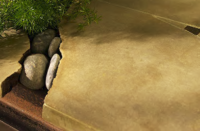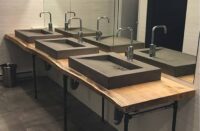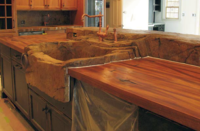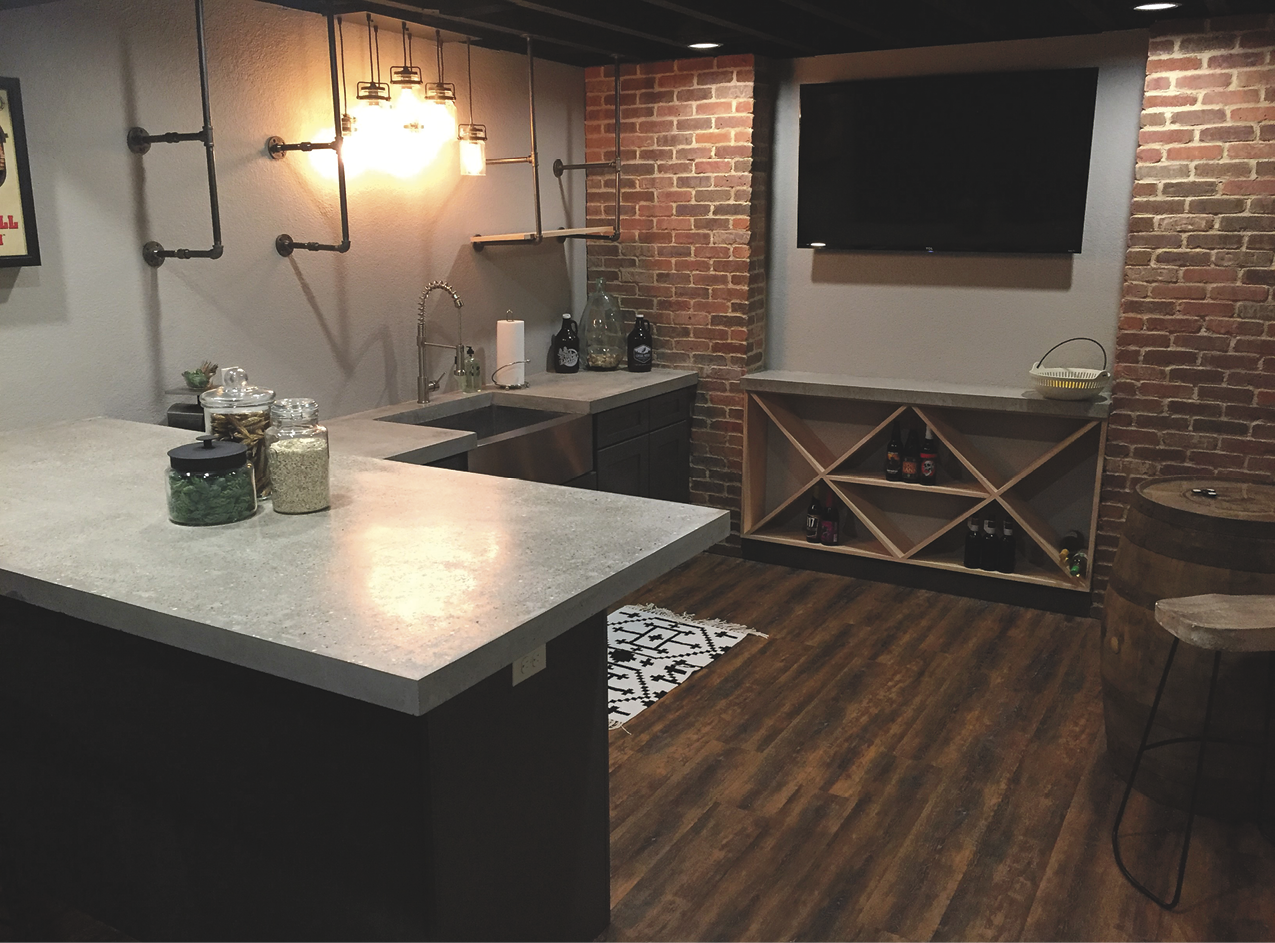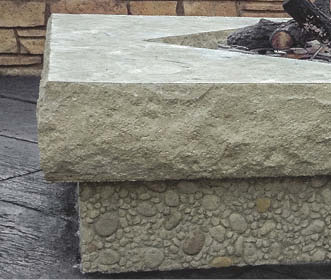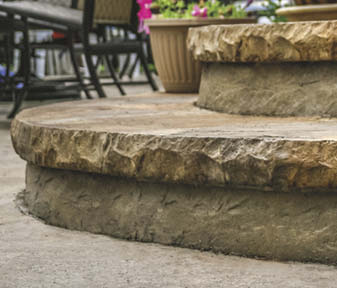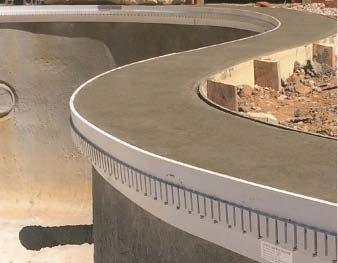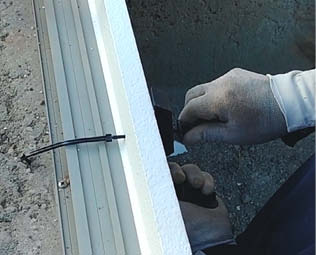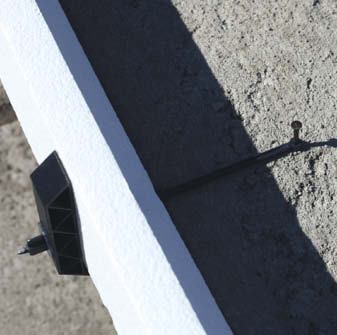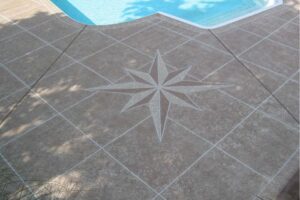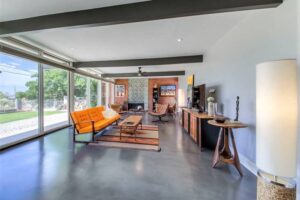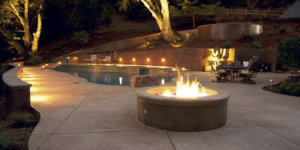When it comes to forming the edges of countertops, pool coping and steps, a good forms and edge liners are indispensable tools. These will help you do the job both quicker and easier. No more hand chiseling or finagling a texture mat to give you a detailed edge.
 Some form liners can provide edge detail that wouldn’t be possible without them. Easy to use, they are simply inserted along a form’s inner edge before placing the concrete into it. Once the concrete is set, you strip the form work and remove the insert to reveal a finished edge. The edge can be left as is or colored.
Some form liners can provide edge detail that wouldn’t be possible without them. Easy to use, they are simply inserted along a form’s inner edge before placing the concrete into it. Once the concrete is set, you strip the form work and remove the insert to reveal a finished edge. The edge can be left as is or colored.
Time-saving steps
If you ask Dan Whitaker, Northeast sales rep for Butterfield Colors headquartered in Aurora, Illinois, he’ll tell you step liners are a great addition to a concrete contractor’s toolbox.
“They make the job go so much smoother,” he says of his company’s step liners that give stair tread edges, risers, wall caps and other vertical surfaces a decorative edge with minimal effort.
 |
|
|
Once the reusable urethane step liners are secured in place, you just place the concrete, vibrate it to eliminate honeycombs and worm holes and stamp the step treads with a texture mat. The next day you strip the forms to reveal the textured risers and the steps are done.
“It’s a big labor savings and it looks better,” Whitaker says. Unlike previously, you don’t have to wait for the concrete to set up before pulling the form, rubbing the face and then stamping the step risers.
Butterfield Colors has about 30 step liners to offer, with its most popular the one-piece cantilever 7¼-inch cut stone. “The top 2 inches looks like there’s actual stone sitting on top of the steps,” he says. There’s also has a 7¼-inch version with a wooden texture that was designed to use with the popular Gilpin’s Falls texture mats.
Pebblestone form liner
Butterfield’s Pebblestone form liner pattern is probably the company’s most unusual design. Photos courtesy of Butterfield Color
The company’s Pebblestone step liner is probably its most unusual design, Whitaker notes. It and some of the other step liners, including cut stone, are available in a 1½- or 2¼-inch size that can be used for countertop edges as well as stairs.
 |
|
|
Some contractors like to combine two step liners to create a more custom look, he adds. “We also make some oversized step liners so you can trim them to fit your needs.”
The liners, which are touted for their realistic look and durability, can be used repeatedly. “I’ve never worn one out,” Whitaker says. They last for a very long time and tend to be tossed when they’ve been “cut and cut” and are only a couple of feet long.
Butterfield designs its form liners with a 45-degree angle where the riser meets the tread to give contractors room to finish the step under the form.
Producing countertops easier
In addition to the Butterfield step liners that you can also use on countertop edges, there are tools explicitly for making fabricating countertops easier.
Concrete Countertop Solutions, headquartered in Scott Township in Northeastern Pennsylvania, introduced its edge forms to the market about 10 years ago. “Z Counterform was the start of everything. That was our entrance into the concrete market,” says Dario Baldoni, vice president of technology and marketing, whose father invented the product and founded the company.
The countertop forms are designed to be used easily and consistently to build cast-in-place, concrete countertops with finished edges. Simply place ½-inch cement backer board on top of the cabinets, fasten the form to the edges and back wall and pour the concrete. After the concrete has cured, pull the form and snap it off.
The extruded PVC forms come with 10 different edge styles that vary in width and profiles from Fancy and Commercial to the company’s best-selling Square Edge.
The forms opened the ability for contractors to cast in place without having to screw into the cabinets or make forms out of wood, Baldoni says. “You cast right on top of the cabinets, so you don’t have to move several hundred pounds of concrete and you don’t have to worry about the counters not fitting properly. And you can form and pour all in one day.”
Timeline expectations
Most contractors then polish and stain the counters and typically seal within four or five days. “With our systems, the kitchen is out of commission about a week,” Baldoni says.
In 2011 to create the look of textured stone or split-rock face without all the work, CCS introduced liner inserts designed to fit inside their Z Counterforms. The reusable form inserts come in six textured patterns in varying sizes and relief. “They’re made of the same material we use to make textured stamps,” Baldoni says. The line’s newest addition replicates woodgrain, he adds.
Pooling resources
By 2014, Concrete Countertop Solutions launched its Z Poolform product for installers who were looking for ways to adapt the countertop system for pools. These forms are for pairing with a form liner. This will help to achieve the desired edge detail.
Made from a pliable PVC, Z Poolforms are reusable. You can also use them with gunite, fiberglass and vinyl liner pools to form cantilevered concrete pool coping in an array of edge profiles and textures, including Chiseled Stone.
According to the company website, the forms lock directly into a liner track on vinyl liner pools, and a special receiver track on fiberglass or gunite pools, eliminating the need for tie-wires. Then you insert rubber form liners into the forms to shape the desired edge, allowing for concrete edge designs that weren’t possible in the past. Currently, there are seven profiles to choose from.
“Our pool forms are all about time and cost savings, and reusability is a big factor,” Baldoni says. “Plus people really like the fact that they can create a textured edge profile — especially the rock face ones — on a pool to match the stamped deck.”
Establishing a new ‘Brackit’
Mortex, a Tucson, Arizona-based company founded in 1962 when it introduced its Kool Deck concrete overlay, offers an array of concrete products ranging from repair, restoration and application to forms for pools, countertops, cornice moldings and cantilever-style steps.
Probably most importantly, Mortex has helped shape the country’s pool industry with both its disposable and reusable forms. This started with reusable forms made from either steel and rubber.
However, says Mark Deason, director of operations, “We found that people would cut and recut reusable forms when attaching to a pool and they would end up cannibalizing their own forms.” Plus, someone had to clean the reusable forms, transport them and take care of them after each use. Their uses were finite, he adds, “A good contractor would only get 10-15 uses out of each form.”
|
|
|
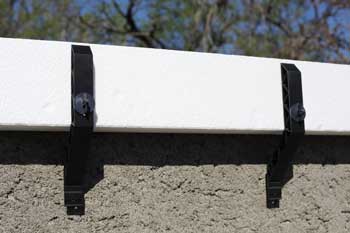 |
|
So Mortex turned its attention to making disposable cantilevered forms out of EPS for each type of pool — fiberglass, vinyl, gunite and cover track — in a variety of profiles from Keystone to Stone Edge. It also introduced its Key Lock attachment system with reusable keys. The keys push through the form into the liner track and lock into place by turning the handle.
Spear and Button locking system
Another anchoring system to the company’s credit is its plastic Spear and Button locking system. This allows forms to quickly set with a click or two. “The spear stays in, and then the button comes off,” Deason says, about the anchoring method he touts to be superior to conventional tie-wire.
Most recently, in 2015, Mortex introduced its Brackit forms. Unlike conventional forms, these don’t have any tape to help them stay in place. Instead, their holding mechanism revolves around reusable brackets specially designed to adhere the forms to various materials.
“Contractors are working with mixed media these days where concrete needs to interface with different items,” Deason says. “The Brackit was invented for people who don’t have tile to attach to.”
He sees a bright future for this innovative product that unites both reusable mounting systems and disposable forms. “It really is the best of both worlds,” he says.
www.butterfieldcolor.com
www.concretecountertopsolutions.com
www.mortex.com
Edge Forms Available Here
Offered by Concrete Decor Store Square Edge - Countertop Edge Form
Square Edge - Countertop Edge Form
by Concrete Countertop Solutions Half Bullnose - Countertop Edge Form
Half Bullnose - Countertop Edge Form
by Concrete Countertop Solutions
